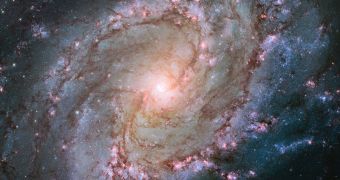A new image released on January 9, at the 223rd meeting of the American Astronomical Society (AAS), held in Washington, DC, showcases the Southern Pinwheel Galaxy (Messier 83). This cosmic object is of great interest to astronomers because it may contain a double nucleus at its core.
The photo was collected using the NASA/ESA Hubble Space Telescope, which was able to capture the bright and mysterious object in tremendous detail. Messier 83 is considered to be the closest large barred spiral galaxy to the Milky Way, and is a known source of massive supernova explosions.
These cosmic events occur when massive stars end their main sequence, and become unable to support nuclear fusion any further. When this happens, they shed the outer layers of their atmospheres in massive blasts, while their cores collapse into either neutron stars, or black holes.
Like all other large galaxies, the Southern Pinwheel features a black hole at its core. However, recent observations have revealed that this nucleus may have a companion. The central region of Messier 83 is very active and luminous, due to its stellar bar. This structure channels matter into the galactic core.
Astronomers say that it is highly unlikely that the core of this galaxy contains a binary black hole system. Instead, it is entirely possible that its supermassive black hole is surrounded by a tight ring of massive stars, which produce large volumes of radiations as seen from Earth.
This lopsided disc of stars may have developed as a consequence of the stellar bar the galaxy features. The Southern Pinwheel is part of the Centaurus A/M83 Group, and is located some 15 million light-years away. Other members of this small cluster include Centaurus A and NGC 5253.
The newly-released image was collected by the Wide Field Planetary Camera (WFC3) instrument on Hubble, which was added to the telescope during the STS-125 mission conducted by space shuttle Atlantis. This was the fourth service mission conducted on NASA's flagship telescope.
Despite its impressive appearance, Messier 83 is roughly 50 percent the size of the Milky Way, which means that its diameter only spans around 50,000 light-years. This relatively small size enabled Hubble to image it in full, and in natural colors.
The darker areas in the photo are massive dust lanes, which play a role in promoting stellar formation. The large number of massive stars that developed in the Southern Pinwheel is responsible for the multiple supernovae observed within, including SN 1923A, SN 1945B, SN 1950B, SN 1957D, SN 1968L, and SN 1983N.
Astronomers say that in excess of 3,000 stellar clusters have been identified in this galaxy to date. A significant percentage of these structures are extremely young, at less than 5 million years old. For comparison, the Milky Way began forming around 10 billion years ago, and the Sun is 4.6 billion years old.

 14 DAY TRIAL //
14 DAY TRIAL //